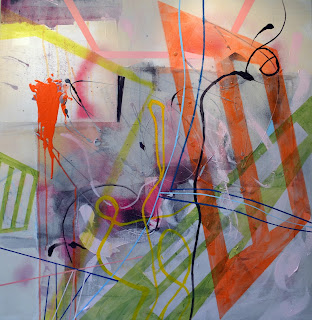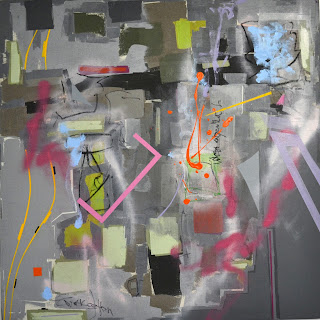For my first-year project, I had suggested to
create a sound piece. My intention was to explore sound
as a completely new medium for me.
In my work so far, through
painting, I had been investigating the different identities places take on over
a period of time. Still working with the same theme, identity, I wanted to
compare events from the past and juxtapose those to current events.
I had proposed to create 5
different sound loops and wanted to juxtapose one sound loop – with voices of
right wing extremists who are meeting weekly on the streets of Dresden,
demonstrating against the politics of the German government and against
accepting refugees from Syria or other countries– to four sound loops that
would represent Germany’s past.
The four sound loops representing
Germany’s past were to consist of the following material:
- Excerpts of a two-hour interview I had done with Holocaust survivor Dr.
Peter Gary, (1923-2016), who was born in Poland in 1924 and was arrested by
Nazis in 1941 together with his mother, who was shot when she tried to protect
him. Gary survived the Warsaw Getto, was then sent to Majdanek, then Dachau
and, finally, Bergen-Belsen. At the age of 21, he was liberated from
concentration camp in April 1945 and survived the Shoah.
- the voices of the Nazis at the famous Wannsee Conference where, in 1942,
the ‘Endloesung’, the ‘Final Solution of the Jewish Question’ had been
discussed by senior officials of Nazi Germany.
- the voice of Hitler, his famous ‘Prophecy’ in which he talks about the
extinction of the Jewish race.
- my own voice reading Paul Celan’s famous poem ‘The Death Fugue”. Paul
Celan, born in 1920 in Romania, was one of the major German-language poets
after the Second World War who had survived the Holocaust.
I had suggested that my sound
installation could be presented with 5 head phones hanging from the ceiling in
a room together with a selection of my new paintings.
By presenting these 5 loops
together my intention was to remind the listener of the past and to explain the
propaganda of the Nazis. I wanted to juxtapose the consequence of this
aggression to current propaganda of hate against people who would need our help
and support.
When I started to put
my 5 loops together, I realized there
were no original recordings of the Wannsee Conference available. I was only
able to get a hold of recordings done by actors for the movie Die Wannseekonferenz from 1984. (https://youtu.be/URSNN5mnI2g).
That was when I decided to bring a
further element into my proposed installation; a projection of the text of the
protocol of the Wannsee Conference. My idea was to project the text that would flow down a wall with persistent
continuity, over the ground, so that it flows over viewers in the room. At the
Wannsee Conference, which took place on January 20th, 1942, the systematic mass produced
death of the European Jewry was decided upon.
Once I had put together and isolated the
other 4 sound loops mentioned above I decided to take my initial proposal one
step further: I decided to create a video.
A film, in which I would include my
individual sound pieces, but I also wanted to show images of burning refugee
homes in Germany and images of those people who are the victims of the hate of
those demonstrators. With his projection of images of
the past onto the present sites, Shimon Attie, with his installation The Writing on the Wall, inspired me to
project my collection of sounds of the past that represent experiences of the
Holocaust onto images of the present.
During my artist residency in Berlin in January
to March 2016, I had met several Syrian refugee artists. Since the newly arisen
right wing extremism in Germany is directed against Muslims this time,
especially against refugees from Syria, I wanted to
give agency to a refugee from Syria. The video includes parts of an interview I
had recorded in Berlin in January 2016 with Farid Abd Albaki, a ceramic artist
from the city of Homs.
In the video, I project my voice
reading a poem by Holocaust survivor and writer, Primo Levi, onto images of
burning refugee homes in Germany today. I projected the voice of Dr. Peter Gary
onto right wing populists’ and extremists’ marches occurring weekly in Dresden,
demonstrations against the acceptance of war refugees from Syria. Also, I have
included images of refugees on their odyssey to and through Europe while one
hears the voice of Farid telling his story. The video shows images of the
destroyed city of Homs in Syria from 2016 and propounds a new genocide with the
killing of minority groups during the Syrian civil war. I projected my voice
reading Paul Celan’s Todesfuge (Death Fuge) onto those images of the destroyed
city of Homs. The recording of the sound piece Todesfuge was a collaboration
with a composer from New York, Concetta Abatte, who I had met during my residency
in Berlin.
Ira
Hoffecker, Image of burning refugee home in the video Black Milk of Daybreak,
15 min, 2016
With the video I intend to
juxtapose newly arisen hate against foreigners, currently against Muslims to
experiences of the Holocaust. I want to suggest how things can escalate if the
people of a country do not stand up and protect each other.
Here is the link to the video: https://vimeo.com/203736016
After the feedback I received at
the residency in New York, I broke down the video into four individual videos.
During my second-year MFA I plan to continue to work on this installation
together with a couple of further videos I want to create:
a) The
Todesfuge projected on images of the destroyed city of Homs https://vimeo.com/212258990
b)
The interview with Fareed together with images of people on their odyssey from
Syria to Europe https://vimeo.com/212299348
c)
Primo Levi’s poem projected on Burning Refugee Homes https://vimeo.com/212278837
d) Showing
right wing extremists in Germany https://vimeo.com/212360183
This video was a further
development of my previous photo series (presented in the fall semester 2016) pertaining
to 12 different genocides. I created a series of images that are set against
the Facebook imagery which I then juxtaposed with the different genocides by
mentioning the year and the place where they occurred. I was inspired by
Hiller’s juxtaposition of normal daily life in today’s Germany to the
Holocaust.
Ira Hoffecker, Photo
1/12 of photo series pertaining to genocides, 16x20 inches, 2016
In my photo series, I used the
shadow of my own body in different places. In my video, I used my own voice. I
wanted to use my own body as a tool for introspection: I investigate my role in
relation to the history of my ancestral culture and my own family and to my
presence in this world today. By using my body, I ask myself what I would have
done if I had lived under the Nazi regime. Would I have stood up and defended
others or would I have been a coward and shut up?
My work reflects on our role as
people today, asking, how we may be paralyzed, when we should stand up and try
to prevent bad things from happening. I want to inspire the viewer to think
about his or her own role. I am interested in how Germans deal with collective
memory, with forgetting and suppressing the past as opposed to remembering and
comprehending.
In my paintings, I overlay maps
from today onto maps of the Third Reich to examine the divergent identities of
those places over time. In some areas of my paintings the underlying map is
covered with new layers of paint, whereas in other areas I sand the surface
down to the previous layers. I use the covering as a metaphor for forgetting
and the sanding down as a metaphor for coming to terms with our past.
For my first-year MFA I had also
suggested to create a series of 4 to 6 big paintings that still talk about
historic layers and different identities over time. I wanted to focus on the
story and different historic layers of Camp Moschendorf and use elements out of
the maps I have. While discussing painting with Andrew in Berlin, my intention
was to abstract my work more, to go away from merely putting two maps on top of
each other, I started to abstract my paintings more and experimented with
introducing brushwork to my paintings.
Here are the paintings I worked on this first year: all are acrylic on birch wood panel:
untitled - 24 by 30 inches
untitled II - 24 by 30 inches
Structure I - 36x36 inches
Structure II - 36 by 36 inches
Structure III - 40 by 60 inches
Structure IV - 40 by 60 inches
Structure V 40 by 40 inches
Camp Moschendorf V 24 by 48 inches
Structure VI 40 by 60 inches - unfinished
Scheunenviertel VIII - 40 by 60 inches - unfinished
I started to let my work become
more lose and not so literal anymore. I feel I need to push this further. In
this new series Structure I – Structure V I unfolded the current factory
building that stands today where the former Camp (Lager) Moschendorf was
located.
Before I had started this MFA I
had only worked with painting and sculpture, never with sound or video. My
intention was to experiment with the medium trying to find different ways how I
can talk about German identities over the course of time. I realized that the
medium film allows me to speak about this subject in a very different and more
precise way.
I realized I need to think to approach the
themes I want to discuss from a much broader perspective. Historic readings for
my research of German identity are important, but also the study of other
artists who explore the same theme. In my thesis, I had discussed the work of
Shimon Attie, The Writing on the Wall,
Susan Hiller and her J-Street-Project
and Christian Boltanski’s The Missing
House. Their work is very different but their work and my work all talk
about memory and German identity. Here is the link to my first-year paper: http://transartih.blogspot.ca/
Besides the above-mentioned work, I had
also created several sound pieces. I had experimented with overlaying voices.
In the beginning, I also experimented with the medium video and created a video
with my images of Berlin, ‘Ode to Berlin’. https://vimeo.com/182799079
If you would like to look at my work in
more detail and see all the process work of the past first MFA year, please see
all my monthly blog posts:
http://transartih.blogspot.ca/, http://transartih.blogspot.ca/2016/11/november-15th-blog.html, http://transartih.blogspot.ca/2016/12/dec-15-post.html, http://transartih.blogspot.ca/2017/02/february-15th-post.html, http://transartih.blogspot.ca/2017/03/blog-post-march-15.html, http://transartih.blogspot.co.uk/2017/04/april-15th-blog-post.html










